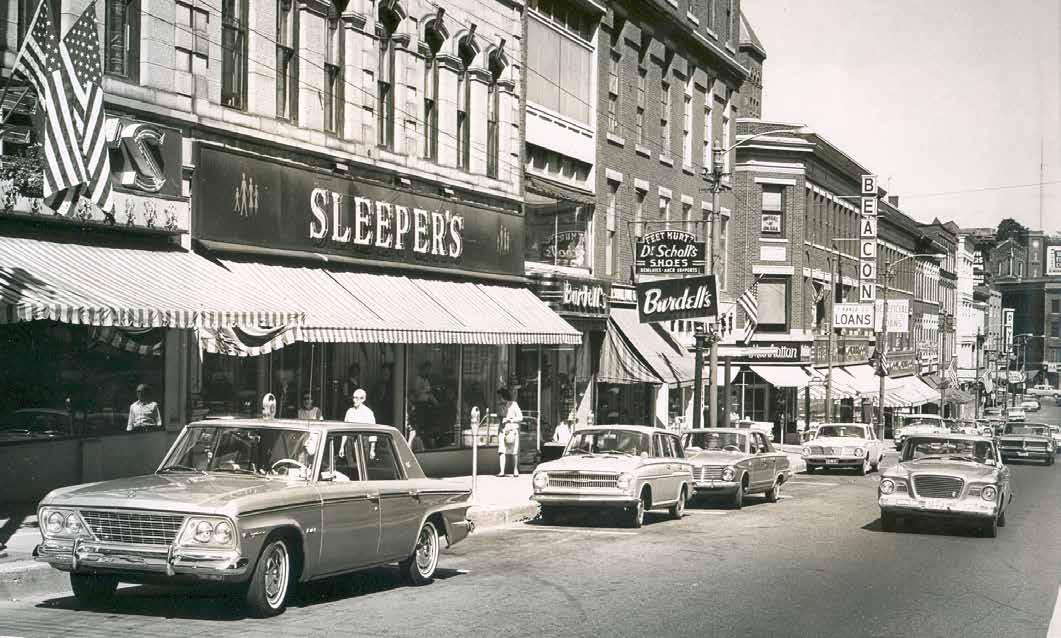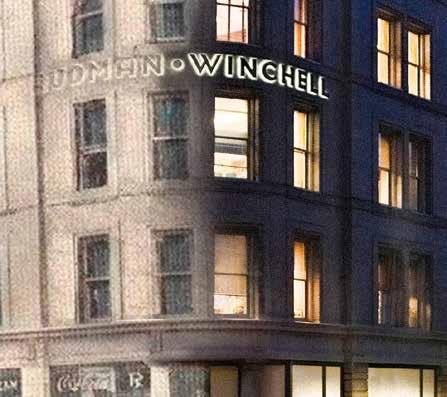
4 minute read
EXPLORE THE QUEEN CITY’S VIBRANT HISTORY
BY ANNE GABBIANELLI
As I sift through the yellowed, fragile, bound pages of the 1938 Bangor Daily Commercial newspaper, I’m reminded of the value of these treasured types of documents. For example, one page shared the good news that Bangor’s Godfrey Field is being eyed for an Army Air Base, another spoke of a blizzard that ripped through at Thanksgiving time, and there are numerous ads, some promoting whole milk — three tall cans for 23 cents, and fur coats priced just under $70. Bangor is unique in its long and varied history. How could you top the story that gangster Al Brady was gunned down by FBI agents on Central Street in 1937, leaving his body straddling the trolley tracks? In 1935, Brady, part of a criminal trio, was the object of one of the greatest manhunts in the history of American crime. That manhunt ended in Bangor.

The city’s history and landscape were forever altered by the great fire of 1911, a fire so spectacular that it could be seen from Belfast. The city was left in ruins.




“The fire not only destroyed so many of the buildings showcasing our lumbering heritage, but so many large portions of the city archives as well,” said Matt Bishop, curator and operations manager of the Bangor Historical Society.
Bangor historian and writer Richard Shaw claimed that while the fire “destroyed 55 acres of downtown real estate, it failed to quell the Queen City’s spirit.”


Bishop reflected on Bangor’s iconic notes in history.
“Most people will say lumber, Al Brady, and Stephen King. Personally I feel that it is our location,” he said. “Being that crossroads of eastern, northern, and central Maine, where we are at the head of tide on the Penobscot [River], the ships could get to this point for travelers and goods as well as the lumber coming downriver.”
When it was incorporated as a town in 1791, Bangor was a trading and sawmill village that grew to become the “Lumber Capital of the World” by the mid-19th century. Many of the lumber barons built elaborate homes, and several substantial churches were built, adding to the beauty of the city. By the 1860s, it was known as the “The Queen City of the East.” Some tend to believe the city got its nickname because of the strand of lights crowning the Thomas Hill Standpipe. Yet, the standpipe, built in 1897, did not add lights to its crown until 1912.

Running rum was a big business out of Bangor’s port, despite municipal efforts to curtail the activity. In 1853, the publication Bangor Democrat quoted a Boston newspaper: “There has been enough rum sent hence to Bangor lately to give even river water a contraband tincture.”
In 1861, the Second Maine Infantry marched off to war with music from the Bangor Band, which was incarnated in 1859 and still provides entertainment today.
The 1880s saw the construction of Morse’s Bridge, a covered bridge spanning the Kenduskeag Stream, and the creation of the Tarratine Club, a social club of elite local businessmen, which named former U.S. Vice President Hannibal Hamlin as its first president. The club building still exists today on Park Street and includes a restaurant.
In the early 1900s, Bangor saw the construction of what is now the Dorothea Dix Psychiatric Center, frequent appearances by Barnum and Bailey’s Greatest Show on Earth, bridge construction over the Penobscot River, and the steamer “City of Bangor,” which sailed three times a week.



The military called Bangor home, with significant development near the location of the current Army and Air National Guard bases. When Dow Army Air Field, later called Dow Air Force Base, closed after nearly 30 years of operation, Shaw said some predicted Bangor would go “bust.”
“That also failed to quell the Queen City’s spirit,” he added.
Many dignitaries traveled through Bangor, including President Ulysses S. Grant, who spent an overnight at the Bangor House in 1871. The Bangor House was also a backdrop for Presidents Theodore Roosevelt and William Howard Taft, who delivered speeches in the early 1900s. In 1909, Adm. Robert E. Peary visited Bangor on his return from the North Pole, and Amelia Earhart visited the airport in 1934.
The Opera House that burned in 1914 was rebuilt and opened six years later with entertainers like Jack Benny. If you saw pictures after that fire was quenched, you’d be reminded of the January 2004 blaze at the Masonic Temple Association building. Nearly 5 million gallons of water encased the building, reminiscent of the ice-sealed Opera House. Down the road in 1959, the iconic Paul Bunyan statue was erected, never wavering from his spot along Main Street all these years.


In sifting through “Headlines in History: 100 Years of Front Page News” by the Bangor Daily News, I was taken back to 1991, when hundreds of soldiers touched down on American soil after months in the Middle East. They experienced a warm Maine welcome at Bangor International Airport. The tradition continued, leading to a Troop Greeters Museum at the airport and a 2009 documentary featuring several dedicated senior citizen troop greeters.
Want More Bangor History?

In addition, the Friends of the Bangor Public Library are selling a 2023 calendar titled “Downtown Bangor: Then and Now.” The calendar is $10 and available at the library and select Bangor businesses.
Another event for the history books occurred in 1992, when Bangor hosted its first ever Transatlantic balloon race. I recall broadcasting live in the wee hours of the morning as five balloons departed from Bass Park.
“The more I wrote about the Queen City, I grew to view it as a nearly unique community in all of America,” Shaw said. “There was the naughty side, the timber barons, the mansions, the hovels. The river boats, the log drives. Bangor’s history has definitely been stellar since its incorporation as a city in 1834. We have survived the end of the lumber boom in the 1870s, fires, floods, the closing of an air base, and still we look to the future. Our 19th-century dream of being a force to reckon with is finally coming true, not with a huge population, but with prestige and respect for diversity.”





After researching more about Bangor’s history, it’s clear Henry David Thoreau was correct following his 1846 visit when he described Bangor as a “star on the edge of night.”












